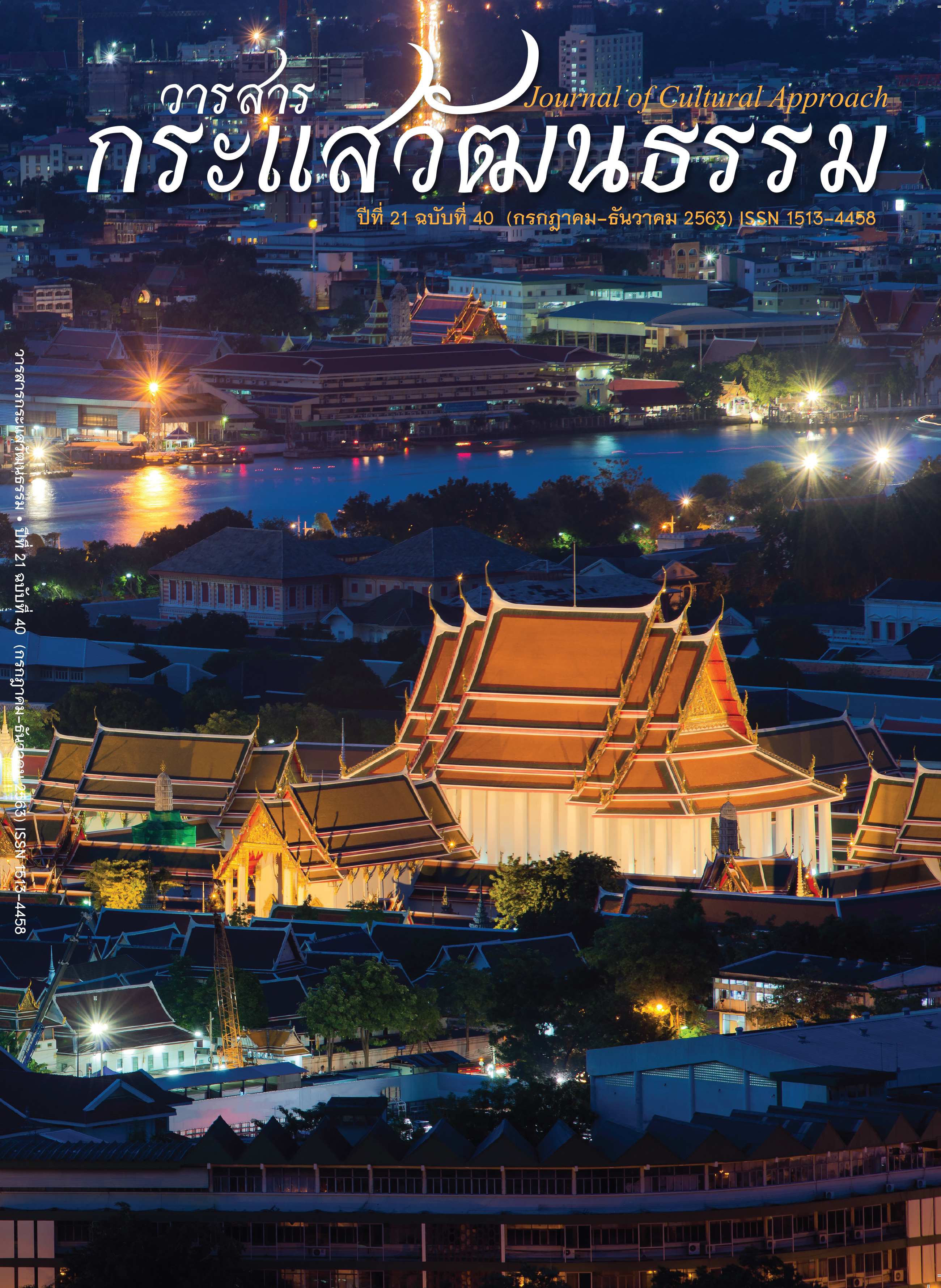ฟ้อนถวยสมมาข้าวตอกมงคล
Main Article Content
บทคัดย่อ
การวิจัยครั้งนี้ มีวัตถุประสงค์เพื่อ 1) พัฒนานาฏศิลป์พื้นเมือง ชุด ฟ้อนถวยสมมาข้าวตอกมงคล และ 2) ถ่ายทอดและนำเสนอนาฏศิลป์พื้นเมือง ชุด ฟ้อนถวยสมมาข้าวตอกมงคล กลุ่มเป้าหมายที่ใช้ในการวิจัย ได้แก่ ปราชญ์ท้องถิ่น และชาวบ้านสามแยก อำเภอเมือง จังหวัดเลย จำนวน 15 คน ครูผู้สอนนาฏศิลป์ จำนวน 5 คน และนักศึกษาสาขาวิชานาฏศิลป์ มหาวิทยาลัยราชภัฏเลย จำนวน 12 คน ใช้วิธีวิจัยเชิงคุณภาพ ผลการวิจัยพบว่า 1) การพัฒนานาฏศิลป์พื้นเมือง ชุด ฟ้อนถวยสมมาข้าวตอกมงคล มีขั้นตอนการดำเนินงาน ดังนี้ (1) กำหนดพื้นที่ (2) กำหนดแนวคิดการแสดง (3) กำหนดรูปแบบการแสดง (4) กำหนดองค์ประกอบการแสดง (5) ออกแบบท่ารำและการแปรแถว รูปแบบการแสดงนำเสนอในลักษณะการแสดงนาฏศิลป์พื้นเมืองสร้างสรรค์ โดยผู้วิจัยได้ออกแบบดนตรีประกอบ เนื้อร้อง เครื่องแต่งกายและอุปกรณ์ประกอบการแสดง ที่สื่อความหมายถึงวิถีชีวิตและบริบทในท้องถิ่นของชาวอีสาน 2) ผลการถ่ายทอดและนำเสนอนาฏศิลป์พื้นเมือง ชุด ฟ้อนถวยสมมาข้าวตอกมงคล พบว่า (1) แนวคิดของการแสดงสื่อให้เห็นถึงความสำคัญของข้าวตอกต่อวิถีชีวิตของคนอีสาน (2) ด้านรูปแบบการแสดง นำเสนอถึงวิถีชีวิตที่เรียบง่าย ท่าทางอ่อนน้อม แต่แฝงความสนุกสนาน มีเอกลักษณ์เฉพาะ (3) ด้านองค์ประกอบ ดนตรีประกอบเข้ากับแนวคิดของการแสดง เนื้อร้องสื่อความหมายชัดเจน เหมาะสมกับท่ารำ การแต่งกายและอุปกรณ์ประกอบการแสดงเหมาะสม (4) การออกแบบท่ารำครอบคลุมความหมายของเนื้อหา มีการแปรแถวทำให้เกิดความน่าสนใจ
Article Details
Proposed Creative Commons Copyright Notices
1. Proposed Policy for Journals That Offer Open Access
Authors who publish with this journal agree to the following terms:
- Authors retain copyright and grant the journal right of first publication with the work simultaneously licensed under a Creative Commons Attribution License that allows others to share the work with an acknowledgement of the work's authorship and initial publication in this journal.
- Authors are able to enter into separate, additional contractual arrangements for the non-exclusive distribution of the journal's published version of the work (e.g., post it to an institutional repository or publish it in a book), with an acknowledgement of its initial publication in this journal.
- Authors are permitted and encouraged to post their work online (e.g., in institutional repositories or on their website) prior to and during the submission process, as it can lead to productive exchanges, as well as earlier and greater citation of published work (See The Effect of Open Access).
Proposed Policy for Journals That Offer Delayed Open Access
Authors who publish with this journal agree to the following terms:
- Authors retain copyright and grant the journal right of first publication, with the work [SPECIFY PERIOD OF TIME] after publication simultaneously licensed under a Creative Commons Attribution License that allows others to share the work with an acknowledgement of the work's authorship and initial publication in this journal.
- Authors are able to enter into separate, additional contractual arrangements for the non-exclusive distribution of the journal's published version of the work (e.g., post it to an institutional repository or publish it in a book), with an acknowledgement of its initial publication in this journal.
- Authors are permitted and encouraged to post their work online (e.g., in institutional repositories or on their website) prior to and during the submission process, as it can lead to productive exchanges, as well as earlier and greater citation of published work (See The Effect of Open Access).
เอกสารอ้างอิง
Amara Klumcharoen. (1988). Thai Classical Dance. Bangkok: O.S. Printing House.
Chantana Aiemsakul. (2011). Dance Design (Thai Creative Dance). Bangkok: Bophit Printing Company.
Chantana Udomsin. (1988). Dance and Drama at the Elementary Level. Faculty of Education, Khon Kaen University.
Charunee Hongcharu. (2015). Movement in the Drama. In Noppamas Wawhong (ed), Introduction to Dramatic Arts. Department of Dramatic Arts, Faculty of Arts, Chulalongkorn University.
Faculty of Fine & Applied Arts. (2002). Acting and Design. Faculty of Fine & Applied Arts, Srinakharinwirot University.
Jaruwan Thammawatra. (1987). Folklore. Srinakharinwirot University, Mahasarakham Campus.
Office of the National Culture Commission. (1994). The Use and Development of Local Cultural Transfer Processes. Bangkok: the Teacher’s Council of Thailand Publishing.
Pojaman Samakabud. (1995). The Concept of Inventing “Seang”. 2nd ed. Udon Thani Rajabhat University.
Prani Wongthet. (1982). Native Folk. Bangkok: Chaopraya Publishing.
Sangkom Pumipantu. (1991). Folk Media in the Communication of Isan People. Faculty of Education, Srinakharinwirot University, Mahasarakham Campus.
Sriprapi Wanasuth. (2005). The Northeast Local Culture and Dramatics. Faculty of Education, Kasetsart University, Kamphaeng Saen Campus.
Sumonmarn Nimnatipun. (1989). Thai Drama. Bangkok: Thai Watana Panich Publishing.
Surapong Virulrak. (2006). Periscope Dance. 2nd ed. Department of Dance, Faculty of Fine & Applied Arts, Chulalongkorn University.
Yasothorn Provincial Cultural Office. (2008). The Research Study of Participating to Cultural Network and Community for Management: Case Study Hae Malai Kao Tork Ceremony in Mahachanachai District, Yasothon Province. Yasothon: Yasothon Provincial Cultural Office.


